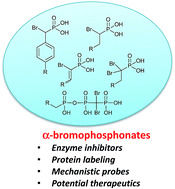Synthesis of α-brominated phosphonates and their application as phosphate bioisosteres
Abstract
Substrate phosphorylation is a key modulator of signal transduction. Abnormal phosphorylation in vivo is implicated in many diseases including cancer, diabetes, and Alzheimer's disease. Inhibitors of phosphate-recognizing proteins have potential as medicinal agents as well as tools to study phosphorylation pathways. A well-known and common inhibition strategy is to synthetically replace the labile phosphate moiety with a non-hydrolyzable phosphonate. Fully saturated, α-fluoro and α,α-difluorophosphonates are often effective phosphate bioisosteres and have been well studied. More recently α-brominated phosphonates have begun to emerge as inhibitors of phosphate recognizing enzymes, some of which operate by irreversible mechanisms. Herein we discuss the synthetic approaches to aliphatic and benzylic α-bromophosphonates and their biological activities.


 Please wait while we load your content...
Please wait while we load your content...